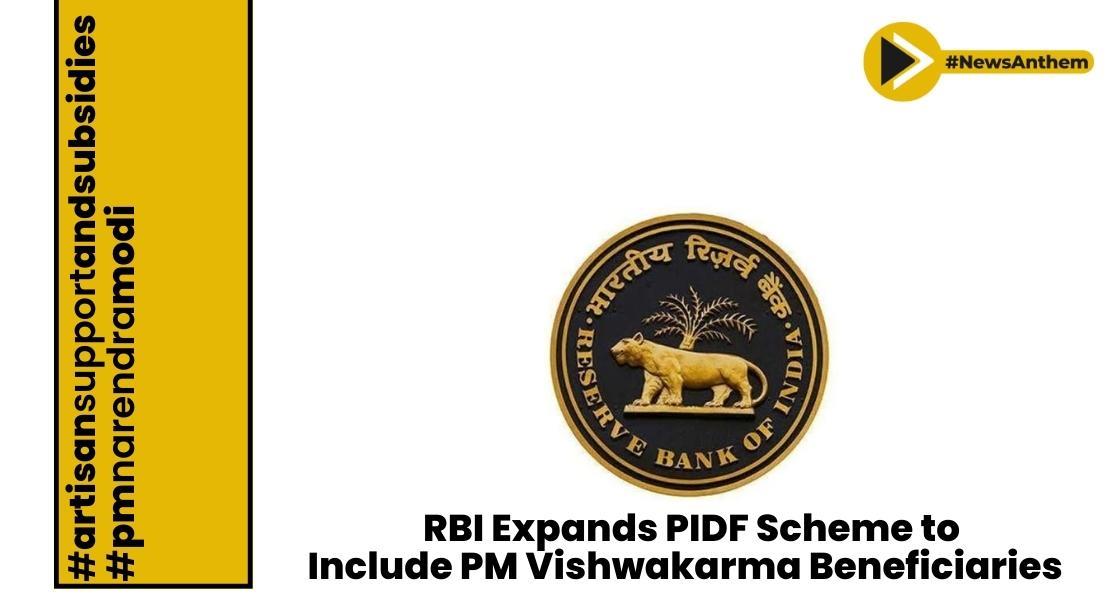RBI Expands PIDF Scheme to Include PM Vishwakarma Beneficiaries and Extends Tenure by Two Years

News Synopsis
The Reserve Bank of India, under the stewardship of Governor Shaktikanta Das, has taken significant steps to enhance the Payments Infrastructure Development Fund (PIDF) Scheme by including PM Vishwakarma and extending its tenure by an additional two years.
PIDF Scheme's Evolution
Operationalized in January 2021, the PIDF Scheme was designed to stimulate the deployment of payment acceptance infrastructure, including physical Point of Sale (PoS) terminals and Quick Response (QR) codes, in tier-3 to tier-6 centers, the northeastern states, and the Union Territories of Jammu & Kashmir and Ladakh.
Initially, the scheme's duration was set at three years, up to December 2023. However, acknowledging the scheme's success and its potential impact, the RBI has extended its tenure up to December 31, 2025.
Inclusion of Beneficiaries
Governor Das revealed that beneficiaries of the PM SVANidhi Scheme in Tier-1 and 2 centers were integrated into the PIDF scheme in August 2021. As of the end of August 2023, over 2.66 crore new touchpoints have been deployed under the scheme.
Building upon this success, it has been decided to further expand the PIDF Scheme by including beneficiaries of the PM Vishwakarma Scheme across all centers. This move is poised to invigorate the RBI's efforts to promote digital transactions at the grassroots level.
Encouraging Emerging Payment Modes
RBI Governor Shaktikanta Das underscored the RBI's commitment to embracing emerging modes of payment acceptance. Soundbox devices and Aadhaar-enabled biometric devices are being promoted under the PIDF Scheme. These initiatives are set to expedite and bolster the deployment of payment acceptance infrastructure in the targeted regions.
Governor Das confirmed that the forthcoming amendments will be notified shortly, marking the beginning of an exciting phase in digital payment adoption.
PM Vishwakarma Scheme
The PM Vishwakarma Scheme, recently launched by Prime Minister Narendra Modi, offers a substantial subsidy of up to 8 percent for loans provided to artisans. This scheme extends collateral-free loans of up to Rs 3 lakh to artisans at an incredibly affordable interest rate of 5 percent.
The scheme encompasses artisans from 18 diverse fields, including carpenters, goldsmiths, blacksmiths, masons, stone sculptors, barbers, and boatmakers. Initially, beneficiaries are eligible for a Rs 1 lakh loan, with the potential to access an additional Rs 2 lakh after a repayment schedule of 18 months.
Furthermore, the PM Vishwakarma Scheme encompasses an array of components, not limited to financial support. It provides access to advanced skill training, knowledge of modern digital techniques, green technologies, brand promotion, linkage with local and global markets, digital payments, and social security.
The RBI's decision to expand the PIDF Scheme to include PM Vishwakarma beneficiaries and extend its tenure by two years is a welcome development. It is expected to boost the government's efforts towards promoting digital transactions at the grassroots level and help artisans to grow their businesses.
Some relevant and latest facts about the PIDF Scheme and the PM Vishwakarma Scheme:
-
The PIDF Scheme has been successful in incentivizing the deployment of payment acceptance infrastructure in rural and underserved areas. As at end-August 2023, over 2.66 crore new touch points have been deployed under the scheme.
-
The PM Vishwakarma Scheme was launched in September 2023 to provide financial and non-financial support to artisans. The scheme offers collateral-free loans up to Rs 3 lakh at an interest rate of 5 per cent, with a subsidy of up to 8 per cent. The scheme also covers the cost of skill training, digital marketing, and branding.
-
The inclusion of PM Vishwakarma beneficiaries under the PIDF Scheme will enable artisans to access digital payment infrastructure at an affordable cost. This will help them to increase their sales and reach out to a wider customer base.
-
The RBI's proposal to encourage the deployment of emerging modes of payment acceptance under the PIDF Scheme is also a positive development. This will help to further accelerate the adoption of digital payments in rural and underserved areas.
The overall impact of these initiatives is expected to be positive for the Indian economy. Digital payments can help to reduce the cost of transactions, increase transparency, and promote financial inclusion. The growth of digital payments can also boost economic growth and create new jobs.
You May Like









